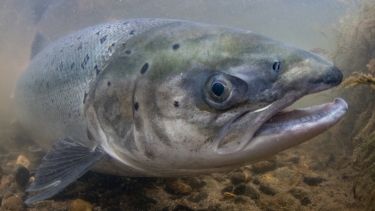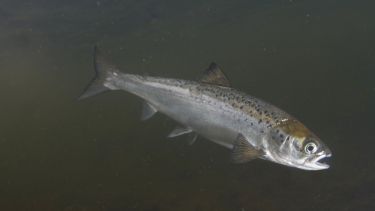Salmon of Steel

This project is a collaboration between the University of Sheffield, the Don Catchment Rivers Trust, Yorkshire Water and the Environment Agency.
Atlantic salmon Salmo salar are a migratory fish species that travel from the sea to spawn on gravel beds in rivers. Salmon were once abundant in the rivers of Yorkshire, including the river Don, which passes through the centre of Sheffield. In the past, shoals of salmon would have been seen jumping through Sheffield's rivers as they travelled upstream to their spawning grounds.
Many of Sheffield's place names are linked to salmon, such as Salmon Pastures and Loxley ('Lox' being an old word for salmon). Up until the 18th century Sheffield had a lucrative and thriving salmon industry. However, the weirs that had been built to power the mills and navigate the rivers, blocked the salmon's migration routes, causing the extinction of salmon from the Don by 1796 (C. Firth pers. comm.).
Pollution resulting from the industrial revolution turned the river Don into a dead river, devoid of life.
Heavy pollution of the rivers began during the industrial revolution and continued until the 1970s. Many factories are still located on the banks of the river Don due to their historic need for water power, or the use of the river as a dump for byproducts and waste.
These included paint manufacturers, the steel industry and even armaments factories during wartime. Legislation safeguarding water quality was passed in the 1970s and was the first step in the attempt to clean up our rivers and allow life to return.
Many agencies have worked hard to remove weirs and create fish passes so that migratory fish, including salmon and eels, can return to their historical spawning grounds. The agencies involved include the Don Catchment Rivers Trust, the Environment Agency, Sheffield City Council, Yorkshire Water and the Canal & River Trust among others.
In 2019, two salmon were spotted in the river Don near Sheffield (Environment Agency, 2019). These were the first salmon to return to Sheffield in 220 years and a cause for celebration. These records indicate that river connectivity has improved and pollution levels have fallen.
We are using new environmental DNA (eDNA) techniques to detect the presence of salmon in Yorkshire's rivers. We will monitor their return and map the extent of their reach upstream. This will help to identify barriers to their migration routes in order to focus efforts at these sites to remove these obstructions. Water samples have been taken at various locations along the river Don and Dearne and will be tested for the presence of salmon DNA.
Listen to our Salmon Story podcast to hear more about our research.
Salmon images kindly supplied by Jack Perks Photography.
Personnel
University of Sheffield
Dr Deborah Dawson, Project Leader (d.a.dawson@sheffield.ac.uk)
Sara Peixoto, Erasmus internee (2019), now at the University of Hull
Dr Paul Parsons, Research Technician
Don Catchment Rivers Trust
Dr Ed Shaw, Director
Chris Firth MBE, Trustee & Director
Sally Hyslop, Community Engagement Officer
Environment Agency
Neil Trudgill, Fisheries Technical Specialist
Katie Burnham, Don Catchment Fisheries Officer
Yorkshire Water
Dr Ben Aston, Principal Ecologist
Dr Rachel Naden, Invasive Non-Native Species and Biosecurity Advisor
Background reading
- Festival of the Mind 2020 - Salmon of Steel exhibition - sculpture, River Walk map and podcasts
- Firth C (1997) Domesday to the dawn of the new millennium. 900 years of the Don fishery. Environment Agency Report.
- Salmon found in River Don at Sheffield. Environment Agency. 18 January 2019.
- Fish set to scale new heights across South Yorkshire. Yorkshire Water. 7 June 2017.
- The rebirth of the River Don’s fishery. Canal & River Trust. 3 June 2016.
- Putting fish on the "highway" to success. Environment Agency. 21 May 2016.
- Weir removal brings Sheffield's salmon dream closer. Environment Agency. 17 December 2015.
- Leaping salmon seen in Rotherham. Environment Agency. 15 June 2015.
- Bringing salmon back to South Yorkshire. Environment Agency. 23 May 2014.
- Fish enticed back to spawn in South Yorkshire. BBC Sheffield & South Yorkshire. 28 January 2011.
- Fish find sparks hope for river. BBC News 29 August 2006.
Funding
This DNA study has been funded by an EU Erasmus internship (2019), Yorkshire Water, UK and Research England.


